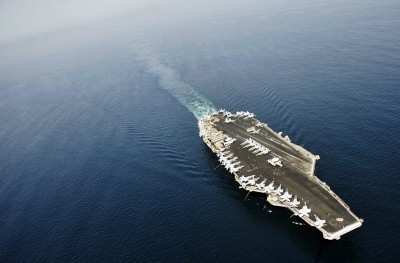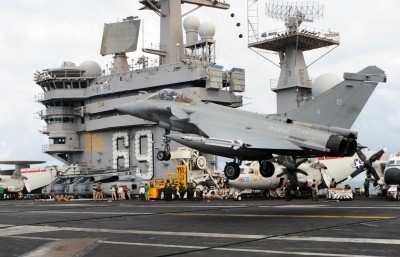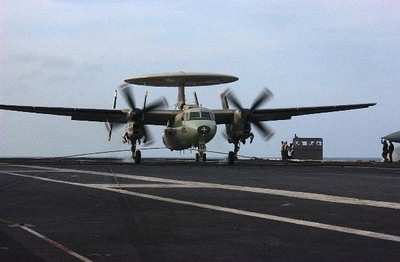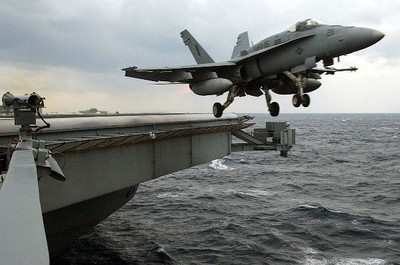Assisted The French Navy With First Underway Aircraft Engine
Swap On A U.S. Carrier
Sailors and Marines deployed with the Harry S. Truman Carrier
Strike Group (CSG) reached the mid-way point of their deployment
September 25th, working closely with coalition nations to support
maritime security operations in the U.S. 5th Fleet area of
responsibility (AOR).

CVN-75 Harry S. Truman US Navy Photo
USS Harry S. Truman (CVN 75), the embarked Carrier Air Wing
(CVW) 3, and embarked Destroyer Squadron (DESRON) 26, along with
USS Normandy (CG 60), and the German frigate FGS Hessen (F 221)
conducted a number of multinational exercises and operations within
the U.S. Navy's 6th before arriving in the 5th Fleet AOR.
Shortly after deploying May 21, the Truman Carrier Strike Group
participated in evolutions marking the 100th anniversary of French
naval aviation. The joint interoperability exercises with French
aircraft carrier Charles de Gaulle (R 91) culminated with French
aircraft trapping aboard Truman and F/A-18s and E-2s assigned to
CVW 3 touching down on Charles de Gaulle (R 91). Additionally,
Truman's hanger bay was the site of a French Rafale F3 aircraft
jet-engine maintenance removal and replacement evolution.

French Rafale Traps Aboard USS Truman US Navy
Photo
"This was the first time that an engine swap-out with a foreign
navy was done on a U.S. carrier," said Cmdr. Tim Hill. "This was a
big step in working toward the ability to operate a French squadron
on a U.S. carrier."
On June 28, shortly before joining the Truman CSG, Sailors from
USS Winston S. Churchill's (DDG 81) VBSS team assisted two Yemeni
fishermen who had been without food, fuel or water for four days.
The team provided the fishermen with food and water, and stayed
with them until the Yemeni coast guard arrived to escort the skiff
back to land. "As soon as our helo spotted the stranded fishermen,
we knew we had to go help them," said Cmdr. Juan Orozco, USS
Winston S. Churchill commanding officer. "It is every Sailor's
responsibility to help those in need on the high seas. You could
see the satisfaction in my crews' faces, knowing that they had done
a good deed."
USS Elrod (FFG 55) assisted 16 stranded Pakistani fishermen July
5 whose fishing boat had taken on water and sank two days earlier.
After being spotted floating adrift in a life raft by a U.S. Navy
P-3 Orion, the stranded crew was recovered by Elrod's rigid-hulled
inflatable boat (RHIB) and transported back to the ship before
being transferred to the Pakistani Navy destroyer, PNS Babur the
next day.

File Photo Courtesy US Navy
On Aug. 18, units assigned to Truman Carrier Strike Group
rescued eight Iranian mariners in the Arabian Sea after their dhow
caught fire. After being rescued by search and rescue swimmers from
two "Dusty Dogs" helicopters assigned to Helicopter Anti-submarine
Squadron (HS) 7, the mariners were transported to Truman for
follow-on care, where they received medical attention, food and
clothing. The mariners were transferred to Iranian vessel AKL
Chiroo Aug. 20 via RHIB. "I've been a corpsman for twelve years and
this is what I live for; the opportunity to help people," said
Hospital Corpsman 1st Class Jason Legare. "I'm glad that we were
able to help the way we did."
Since arriving in the 5th Fleet AOR June 29, aircraft assigned
to CVW 3 completed more than 3,300 aircraft sorties and logged more
than 10,200 flight hours, with more than 7,200 of those hours in
support of coalition ground forces in Afghanistan.

File Photo Courtesy US Navy
After nearly four months of successful operations and
accomplishments, Truman CSG leadership stresses the importance of
remaining focused on safety and future operations for the 7,000
Sailors and Marines in the Truman CSG. "I am immensely proud of the
work our team is doing here in the Middle East," said Rear Adm.
Patrick Driscoll, commander, Carrier Strike Group Ten. "Our Sailors
have rescued dozens of mariners in distress on the high seas,
interdicted pirates, projected air power in support of US and
coalition troops fighting in Afghanistan, strengthened
relationships and improved the capabilities of our partner navies
in the region, and provided a presence and deterrence to ensure the
free flow of commerce in the maritime commons.
"Our challenge is to continue to execute these many missions in
a safe and efficient manner in this demanding and hazardous
environment. These Sailors and Marines are the best I have deployed
with, and they remain focused on the mission. We want to ensure all
safely return to their families back in our homeport," said
Driscoll.
 ANN's Daily Aero-Linx (05.06.25)
ANN's Daily Aero-Linx (05.06.25) ANN's Daily Aero-Term (05.06.25): Ultrahigh Frequency (UHF)
ANN's Daily Aero-Term (05.06.25): Ultrahigh Frequency (UHF) ANN FAQ: Q&A 101
ANN FAQ: Q&A 101 Classic Aero-TV: Virtual Reality Painting--PPG Leverages Technology for Training
Classic Aero-TV: Virtual Reality Painting--PPG Leverages Technology for Training Airborne 05.02.25: Joby Crewed Milestone, Diamond Club, Canadian Pilot Insurance
Airborne 05.02.25: Joby Crewed Milestone, Diamond Club, Canadian Pilot Insurance






